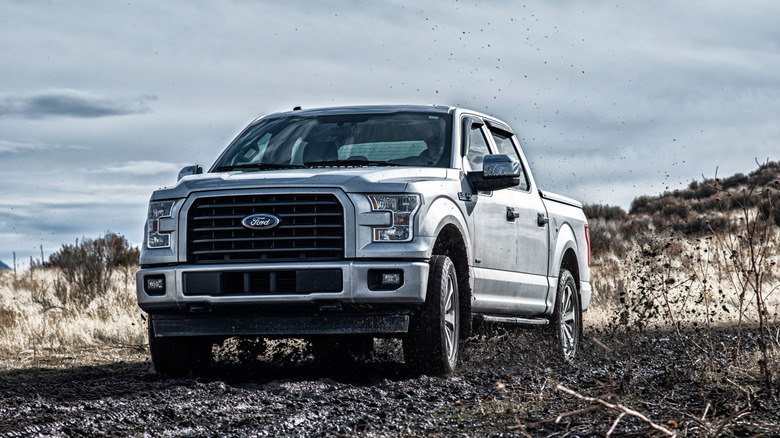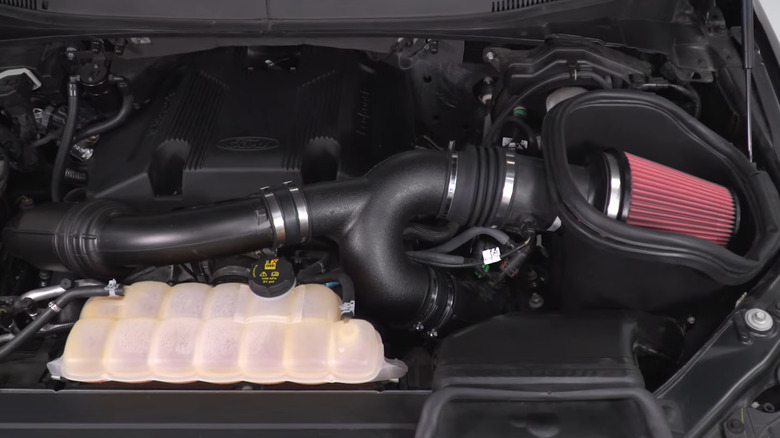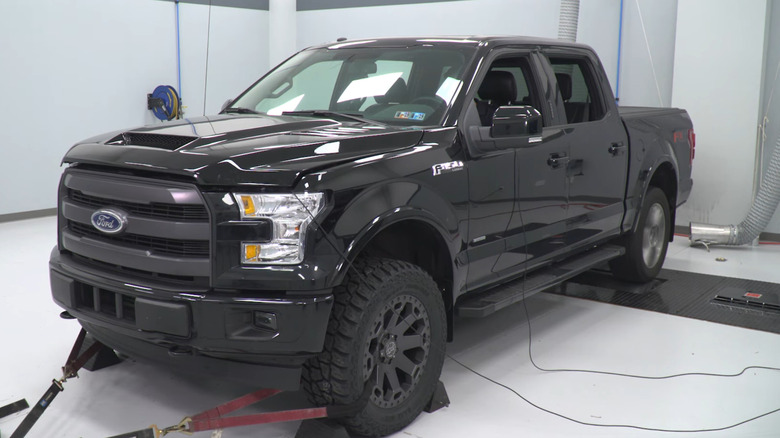How Far Can You Push The 3.5L EcoBoost Engine? This Is How Much Power It Can Output With A Few Mods
Every motorhead dreams of squeezing a little more juice out of their engine, whether it is through simple upgrades like swapping their stock air filter for an aftermarket cold air intake or full-blown conversions and engine swaps, the intention is always the same — more power. Ford's 3.5-liter EcoBoost V6 has earned a reputation for offering a balance between efficiency and power through direct injection, variable camshaft timing, and turbocharging. In fact, EcoBoost is Ford's trademark for its line of direct-injection, turbocharged V6 gasoline engines designed to offer both economy and power, hence the name.
Ford shoehorned the 3.5-liter EcoBoost engine in a number of vehicles, including the Ford F-150, Raptor, and even the Ford GT. Stock, this twin-turbo V6 engine is capable of producing 400 hp and 500 lb-ft of torque in standard output versions, and 450 hp and 510 lb-ft of torque in high-output versions, such as the Ford Raptor.
If you are a gearhead, and you own a 3.5-liter EcoBoost-equipped Ford, you've probably wondered if it is possible to push the limits with basic bolt-on mods like a cold air intake, upgraded intercooler, downpipes, and a proper tune. The short answer is yes. In fact, your EcoBoost engine can get as much as 100 more horsepower without messing with the internals.
The sweet spot for power and reliability (stage 1 and 2 mods)
There's a thin line between doing conservative mods for a slight power bump and going full-blown. Ford EcoBoost engine owners looking for solid power increases without sacrificing efficiency, drivability, and engine longevity often stick with stage 1 or 2 mods. This often includes a high-flow intake, catless downpipes, an upgraded intercooler, and a custom ECU tune.
Justin from the American Trucks YouTube channel put together what he calls "the perfect F-150 EcoBoost" street build with a few basic upgrades. In the episode, he applied both cosmetic and performance mods to the 2017 Ford F-150 powered by a 3.5-liter EcoBoost engine, to make it more fun and responsive. The first performance upgrade was a Ram Air Hood, which featured functional heat extractor vents and inlet ducts, directing cool air into the cold air intake.
He also installed an oil separator, which he insisted was especially useful for earlier direct-injection engines, as it helps prevent carbon buildup on the intake valves. To round off the setup, Justin installed an aftermarket downpipe, retaining the stock cat-back exhaust, to reduce back pressure and enhance turbo spool noise.
The baseline run on the dyno with 93 octane produced 305 hp and 352 lb-ft of torque to the rear wheels. After a 93 octane tune, the truck made 352 hp and 415 lb-ft of torque. The tune alone gave it an additional 50 hp and 60 lb-ft. After installing the air intake and downpipe, and doing a final dyno run, the maximum power output was 379 hp and 422 lb-ft of torque. The overall curve gains were an additional 88 hp and 98 lb-ft of torque, which is quite impressive for a day's worth of performance mods.
You'll need more upgrades maximum power on the 3.5 EcoBoost
Ford's 3.5-liter EcoBoost engine has considerable potential for performance upgrades, resulting in substantial power gains. However, extensive modifications are required (race spec parts), which often involve sourcing upgraded turbos, forged pistons, upgraded fuel systems, and installing methanol injection kits. Here's the truth, folks — builds like this cost an arm and a leg, up to $10,000 in some cases. Still, the rewards are worth the effort.
Compared to stage 1 mods, big builds like these take significantly more time and effort. There are more components to inspect, systems to upgrade, and tests to run. If internal engine parts need to be replaced, it often means a full engine teardown and rebuild. Achieving this level of performance typically requires a forged bottom end, expert tuning, and a properly upgraded fuel system.
Unfortunately, these changes can affect daily drivability while increasing maintenance demands, and depending on your location, may be illegal. That said, with careful planning and execution, the Ford 3.5-liter EcoBoost is capable of making over 700 wheel horsepower. Just make sure to avoid some model years for the 3.5 EcoBoost.


